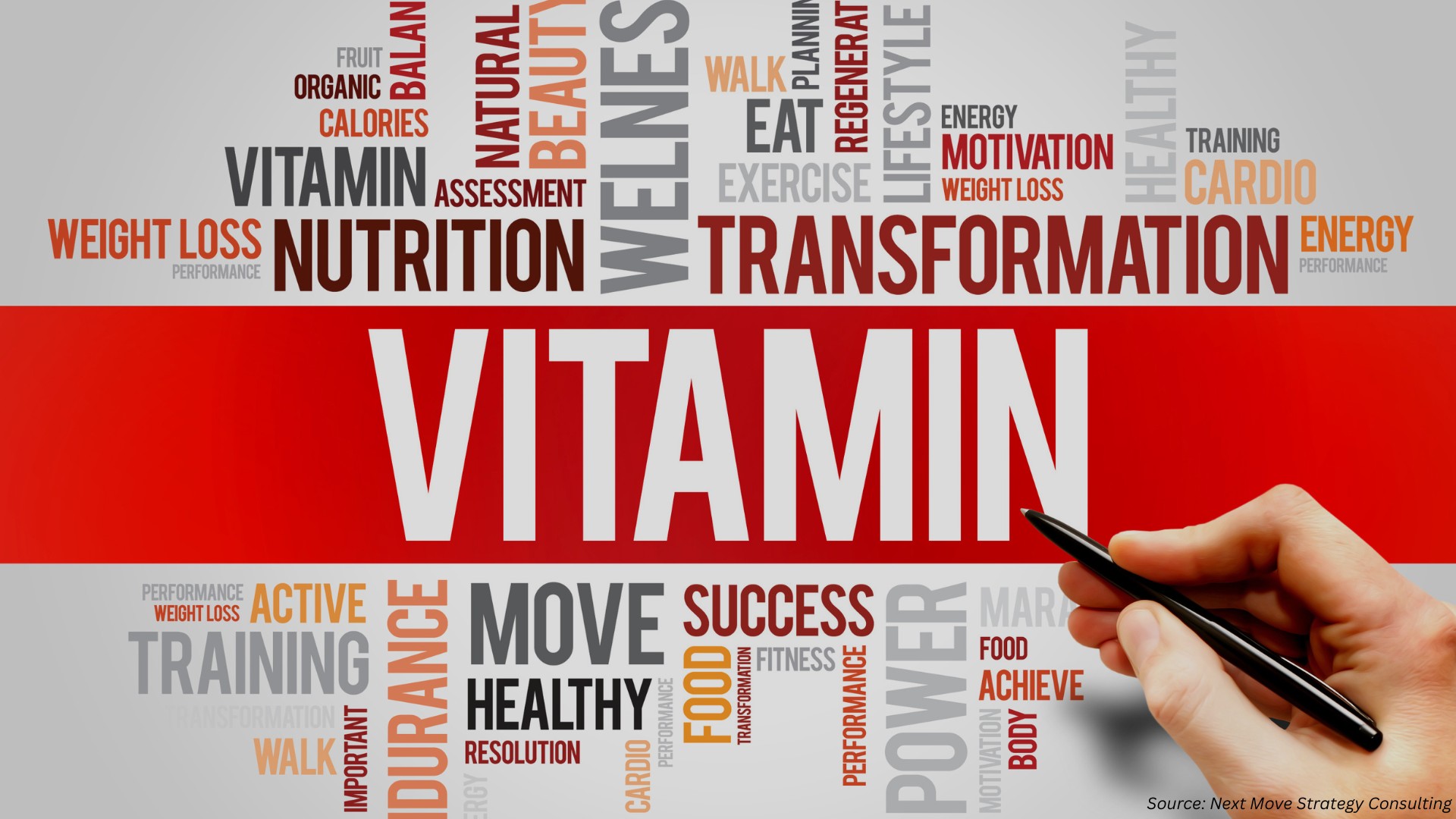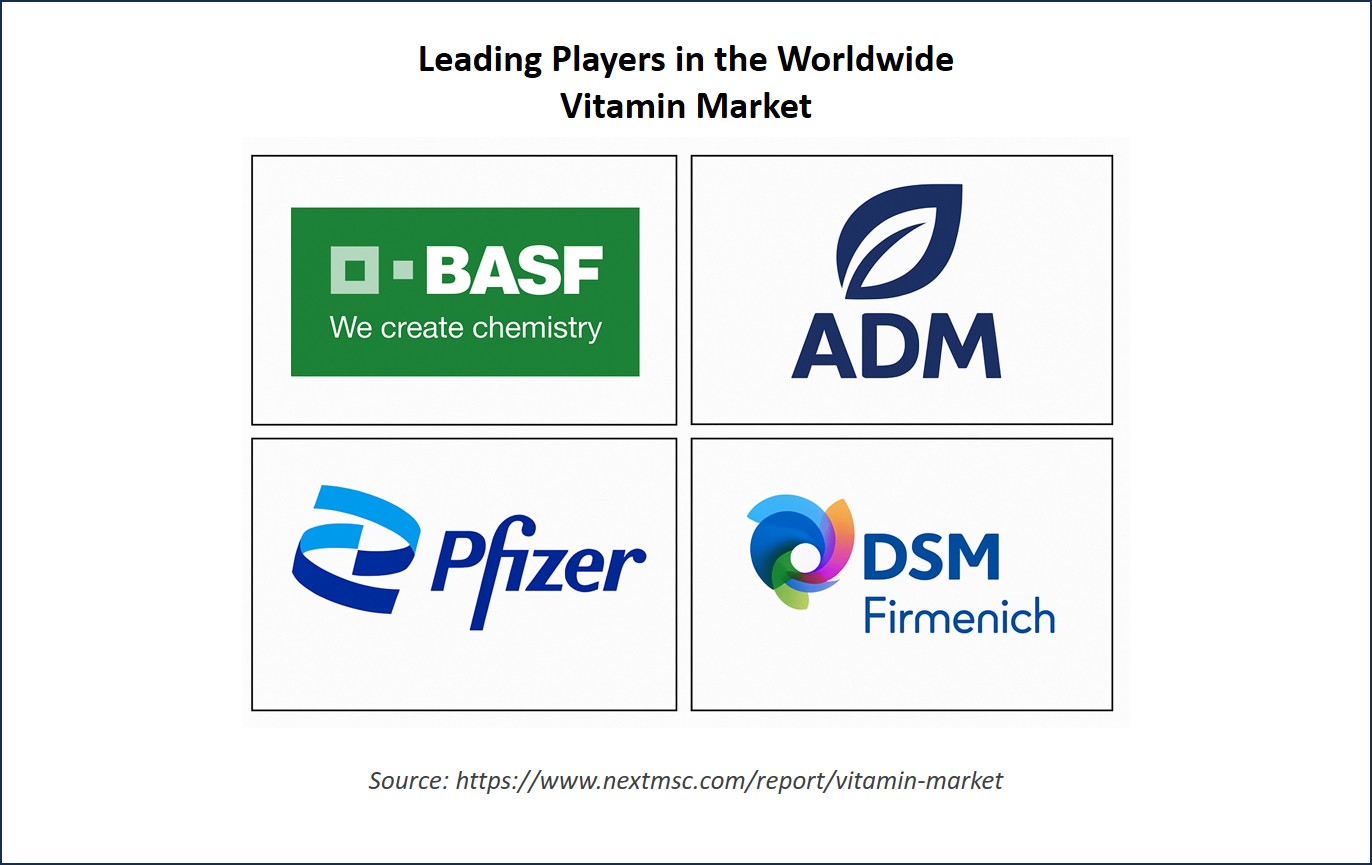What are the Leading Vitamin Companies Doing to Shape the Market in 2024–2025?
Published: 2025-09-10

The global vitamin market is booming, driven by rising health consciousness and demand for preventive healthcare. The market is projected to reach USD 13.30 billion by 2030, with a CAGR of 6%. Leading players like BASF, ADM, Pfizer, and DSM-Firmenich are taking bold steps to stay ahead.
But what exactly are these companies doing to shape the market in 2024 and 2025? This blog dives into their strategies to uncover the moves driving this dynamic industry.
Why Is the Vitamin Market Growing So Fast?
The vitamin market is expanding due to increasing consumer awareness of nutrition and the rising prevalence of chronic diseases. In the U.S., 129 million people live with at least one chronic condition, with 42% having multiple, fueling demand for vitamins to support health management. Companies are capitalizing on this trend through innovation, sustainability, and strategic partnerships.
Key Market Drivers
-
Rising Chronic Diseases: Ninety percent of the nation's $4.9 trillion in annual health care expenditures are for people with chronic and mental health conditions.12 Interventions to prevent and manage these diseases can have significant health and economic benefits.
-
Consumer Preferences: 26% of U.S. consumers are interested in at-home vitamin deficiency testing, reflecting a shift toward personalized health solutions.
-
Global Reach: The Asia Pacific region leads the market, driven by demand for nutritionally enriched foods. For instance, in Oman, people are increasingly seeking products that support their well-being, leading to rising demand for vitamins, minerals, and natural or organic supplements.
-
A key trend is the growing popularity of dietary supplements, driven by busy lifestyles, inadequate nutrition, and a focus on preventive healthcare. Additionally, fortified foods and beverages such as milk, bread, and juices are gaining traction, especially within the functional food sector.
-
The country’s young population, along with government initiatives promoting healthy living, further boosts market expansion. Economic growth and rising disposable incomes have also enabled consumers to invest more in wellness products, while the growing tourism industry is contributing to increased demand from health-conscious visitors.
-
The vitamin market’s growth is fueled by health awareness and chronic disease prevalence, with leading companies aligning their strategies to meet these demands.
How are Leading Companies Innovating in Product Development?
Innovation in product formulations and delivery methods is a cornerstone of the vitamin market’s evolution. Companies are focusing on bioavailability, novel delivery formats, and clinically proven products to meet consumer demands.
BASF: Pioneering Sustainable Vitamin Solutions
BASF, a global chemical giant, is enhancing its vitamin portfolio with sustainable production methods. In 2024, BASF invested in new technologies to improve the bioavailability of vitamins A, D, E, and K, used in food, animal nutrition, and personal care.
-
Key Move: Launched high-potency vitamin formulations for dietary supplements.
-
Impact: Strengthened its position in the premium vitamin segment, catering to health-conscious consumers. BASF is collaborating with By-Health on two projects: developing customized vitamins and nutritional products for seniors with sarcopenia. BASF will support personalized vitamin development by considering raw materials, end products, and regulatory compliance. For sarcopenia-targeted nutrition, BASF will join efficacy studies on conjugated linoleic acid. The partnership also includes regular exchanges on market insights to shape an effective go-to-market strategy. With its global R&D team in Human Nutrition, BASF brings strong support and expertise to the alliance.
ADM: Expanding Vitamin Offerings
Archer Daniels Midland (ADM) is leveraging its agricultural expertise to broaden its vitamin portfolio for food and beverage applications. In 2024, ADM introduced plant-based vitamin solutions to align with consumer demand for natural products.
-
Key Move: Developed vitamin-enriched superfoods for the dietary supplement market.
-
Impact: Captured the growing market for clean-label products.
Pfizer: Focusing on Clinical Efficacy
Pfizer Consumer Healthcare introduced a new line called ProNutrients that includes Omega 3 mini gels, Fruit & Veggie (a mixed plant concentrate), and a Probiotic packet formula. These are positioned as complementing multivitamins, and Pfizer also introduced Centrum Specialist variants focused on Prenatal, Vision, Energy, and Heart health.
What Strategic Partnerships Are Shaping the Market?
Strategic alliances are helping companies expand their market reach and enhance their offerings. These partnerships focus on research, distribution, and technology sharing.
DSM-Firmenich: Collaborating for Innovation
DSM-Firmenich partnered with academic institutions in 2024 to research personalized nutrition solutions, including tailored vitamin supplements DSM-Firmenich.
-
Key Partnerships: In addition to offering a full range of high-quality vitamins, dsm-firmenich has developed the OVN Optimum Vitamin Nutrition® guidelines. Backed by research and created in collaboration with scientists, universities, and industry experts, OVN helps producers determine optimal vitamin levels for animal performance.
-
Impact: Positioned DSM-Firmenich as a leader in personalized nutrition, addressing the 26% of U.S. consumers interested in at-home vitamin testing.
Supply Chain Synergies
BASF’s Care Chemicals division has released its Responsible Sourcing Report for 2024, highlighting ongoing progress in sustainable sourcing and the use of renewable-based materials. The report showcases key initiatives, including a partnership with Solidaridad and Fedepalma to promote sustainable palm cultivation in Colombia. Additionally, advancements in the botanical supply chain are laying the foundation for future innovations in the bioactives sector. In 2024, BASF secured agreements with agricultural suppliers to stabilize vitamin A and E production.
How Are Companies Addressing Sustainability and Consumer Trends?
Sustainability and consumer preferences for natural products are reshape ng the vitamin market. Leading players are adopting eco-friendly practices and aligning with clean-label trends.
Sustainable Production Initiatives
-
BASF: In 2024, BASF reduced carbon emissions in vitamin production. BASF has benchmarked specific vitamin A and E products due to their high CO₂ avoidance potential for customers and is considering extending this approach to other products in its vitamin and carotenoid portfolio. A key contributor to the lower Product Carbon Footprint (PCF) is BASF’s unique Verbund system, which ensures efficient resource use and reliance on lower-emission energy sources and raw materials. To maintain its PCF advantage, BASF is investing in large-scale renewable energy initiatives, including a world-scale wind farm, long-term Power Purchase Agreements, and partnerships for industrial-scale heat pumps to achieve significant emission reductions.
-
ADM: Invested in biodegradable packaging for its products, appealing to environmentally conscious consumers.
Catering to Clean-Label Demand
-
BASF is expanding its Biopolymers portfolio by introducing biomass-balanced ecoflex® (PBAT). The new ecoflex® F Blend C1200 BMB offers a 60% lower Product Carbon Footprint compared to the standard grade. This is achieved by replacing fossil-based feedstocks with renewable, waste-based alternatives, attributed to the product through a certified biomass balance (BMB) approach. As a drop-in solution, ecoflex® BMB maintains the same performance, processing properties, and biodegradability certifications as the conventional version. This innovation supports the packaging industry in increasing the use of renewable feedstocks.
-
ADM is strengthening global food resilience and security through sustainable value chains, such as its partnership with the German government to create a traceable supply chain for certified organic soybeans from India. This initiative trains farmers in sustainable practices, supports 2,000 smallholder farms—including 500 led by women—and promotes long-term environmental conservation. By focusing on ESG, ADM enhances access to affordable, nutritious food while delivering value to stakeholders and driving sustainable growth.
-
DSM-Firmenich caters to clean-label and vegan trends. The company claims its label-friendly, science-based solutions to offer viable alternative to undesirable ingredients. Suitable for a wide range of natural, organic, and non-GMO and VLOG claims, users are supported every step of the way by company experts who work to bring appealing and differentiated products to market.
What Challenges Are Companies Facing?
Despite growth, companies face challenges like supply chain volatility and raw material price fluctuations.
-
Supply Chain Issues: Ongoing disruptions affect raw material availability.
-
Price Volatility: Fluctuating raw material costs threaten profit margins. Rising raw material prices directly raise production costs, posing challenges for industries like manufacturing and construction. To manage this risk, businesses should closely monitor raw material prices and consider long-term contracts or hedging strategies to reduce exposure to price volatility.
-
Pricing Pressure: Volatile raw material costs can force businesses to reassess their pricing strategies. In competitive markets or under strict contracts, passing on cost increases to customers may not be possible, leading to tighter margins. To maintain profitability, companies may need to optimize supply chains or explore alternative material sources.
-
Consumer Hesitancy: Businesses must prioritize data privacy and clear, user-friendly insights. Around 30% of consumers in China, the UK, and the US are willing to use wearable devices only if the data is shared exclusively with them. Requiring excessive manual input or delivering overly complex insights can negatively impact the user experience. To attract and retain users, data collection should be transparent, and insights should be easy to understand and tailored to individual health goals or risk factors.
Supply chain disruptions, price volatility, and consumer hesitancy pose challenges, but strategic partnerships and innovation help companies navigate these hurdles.
Next Steps: Actionable Takeaways for Industry Stakeholders
To stay competitive in the vitamin market, stakeholders can adopt these strategies:
-
Invest in R&D: Focus on bioavailability and personalized nutrition to meet consumer demand for tailored solutions.
-
Strengthen Supply Chains: Form partnerships to secure raw materials and mitigate disruptions.
-
Emphasize Sustainability: Adopt eco-friendly production and packaging to appeal to environmentally conscious consumers.
-
Leverage Clinical Evidence: Highlight clinical efficacy in marketing to build consumer trust.
-
Explore Novel Delivery Formats: Develop gummies, effervescent tablets, or at-home testing kits to enhance convenience.
Conclusion:
The vitamin market’s leading players—BASF, ADM, Pfizer, and DSM-Firmenich—are driving growth through innovation, partnerships, and sustainability. By addressing consumer trends and challenges, they are shaping a market poised for significant expansion through 2025 and beyond.
About the Author
 Sneha Chakraborty is a seasoned SEO Executive and Content Writer with over 4 years of experience in the digital marketing space, bringing a strong command of online visibility strategies and a keen insight into the evolving digital landscape. She specializes in enhancing online visibility and user engagement through data-driven strategies and creative content solutions. Sneha is passionate about translating complex digital concepts into accessible content for a wide audience. Outside of work, she enjoys reading, sketching, and exploring the outdoors through nature photography.
Sneha Chakraborty is a seasoned SEO Executive and Content Writer with over 4 years of experience in the digital marketing space, bringing a strong command of online visibility strategies and a keen insight into the evolving digital landscape. She specializes in enhancing online visibility and user engagement through data-driven strategies and creative content solutions. Sneha is passionate about translating complex digital concepts into accessible content for a wide audience. Outside of work, she enjoys reading, sketching, and exploring the outdoors through nature photography.
About the Reviewer
 Sanyukta Deb is a seasoned Content Writer and Team Leader in Digital Marketing, known for her expertise in crafting online visibility strategies and navigating the dynamic digital landscape. With a flair for developing data-driven campaigns and producing compelling, audience-focused content, she helps brands elevate their presence and deepen user engagement. Beyond her professional endeavors, Sanyukta finds inspiration in creative projects and design pursuits.
Sanyukta Deb is a seasoned Content Writer and Team Leader in Digital Marketing, known for her expertise in crafting online visibility strategies and navigating the dynamic digital landscape. With a flair for developing data-driven campaigns and producing compelling, audience-focused content, she helps brands elevate their presence and deepen user engagement. Beyond her professional endeavors, Sanyukta finds inspiration in creative projects and design pursuits.

















Add Comment